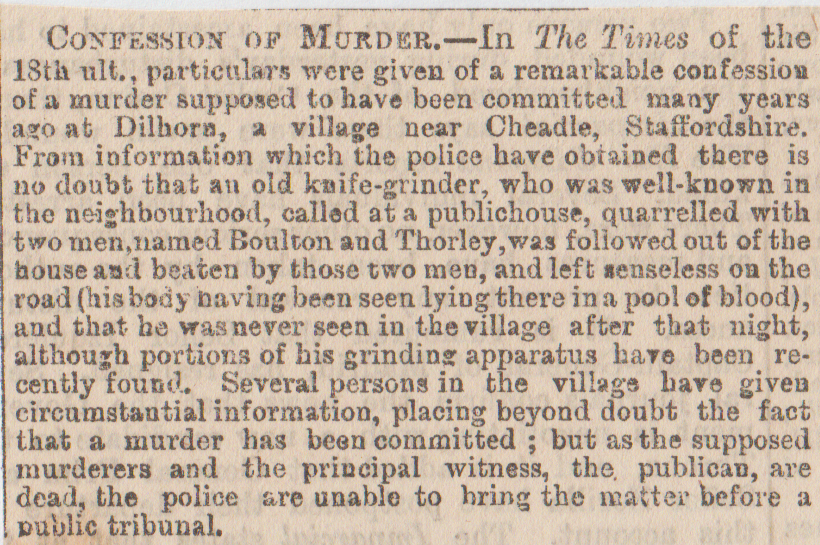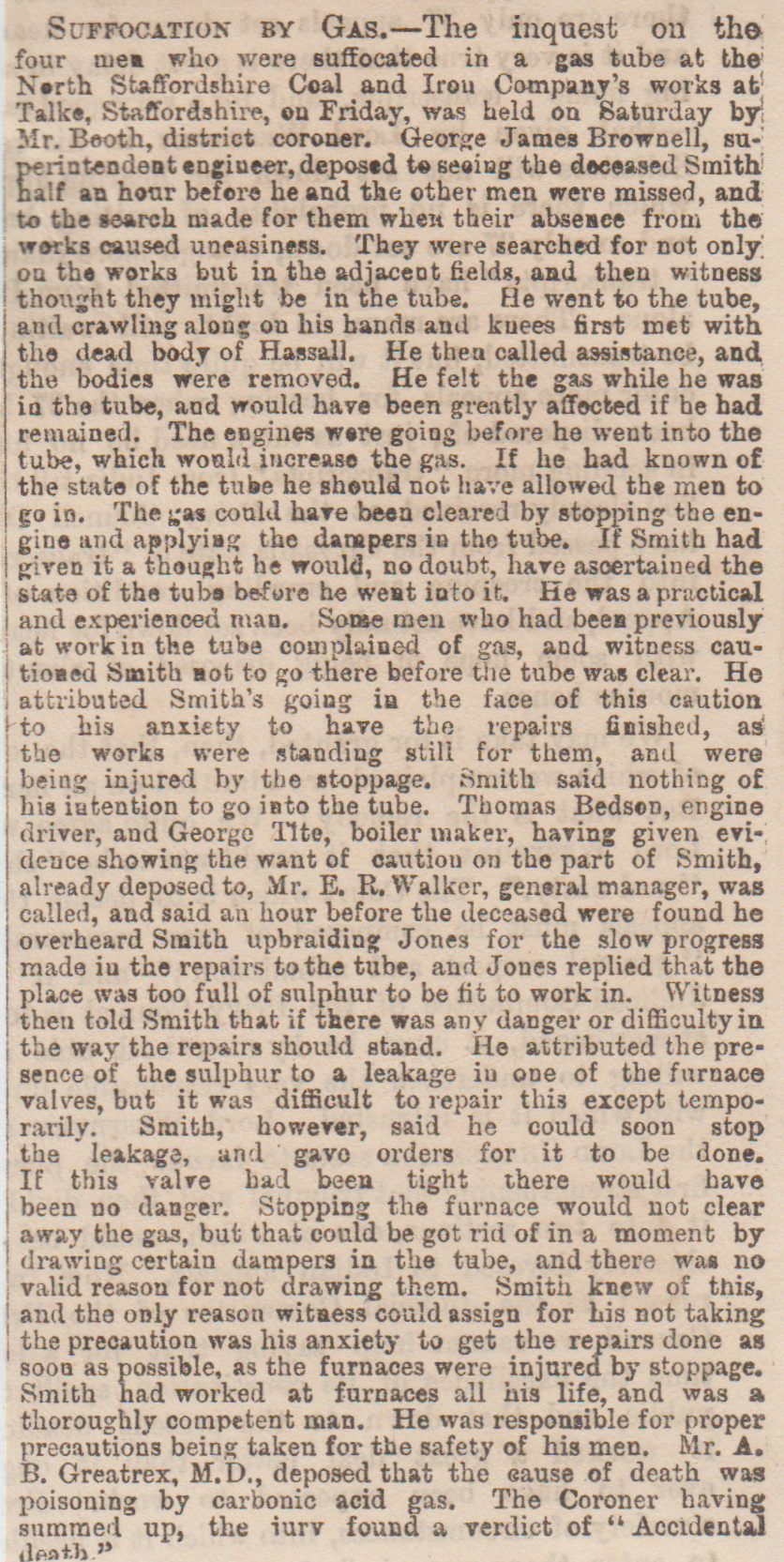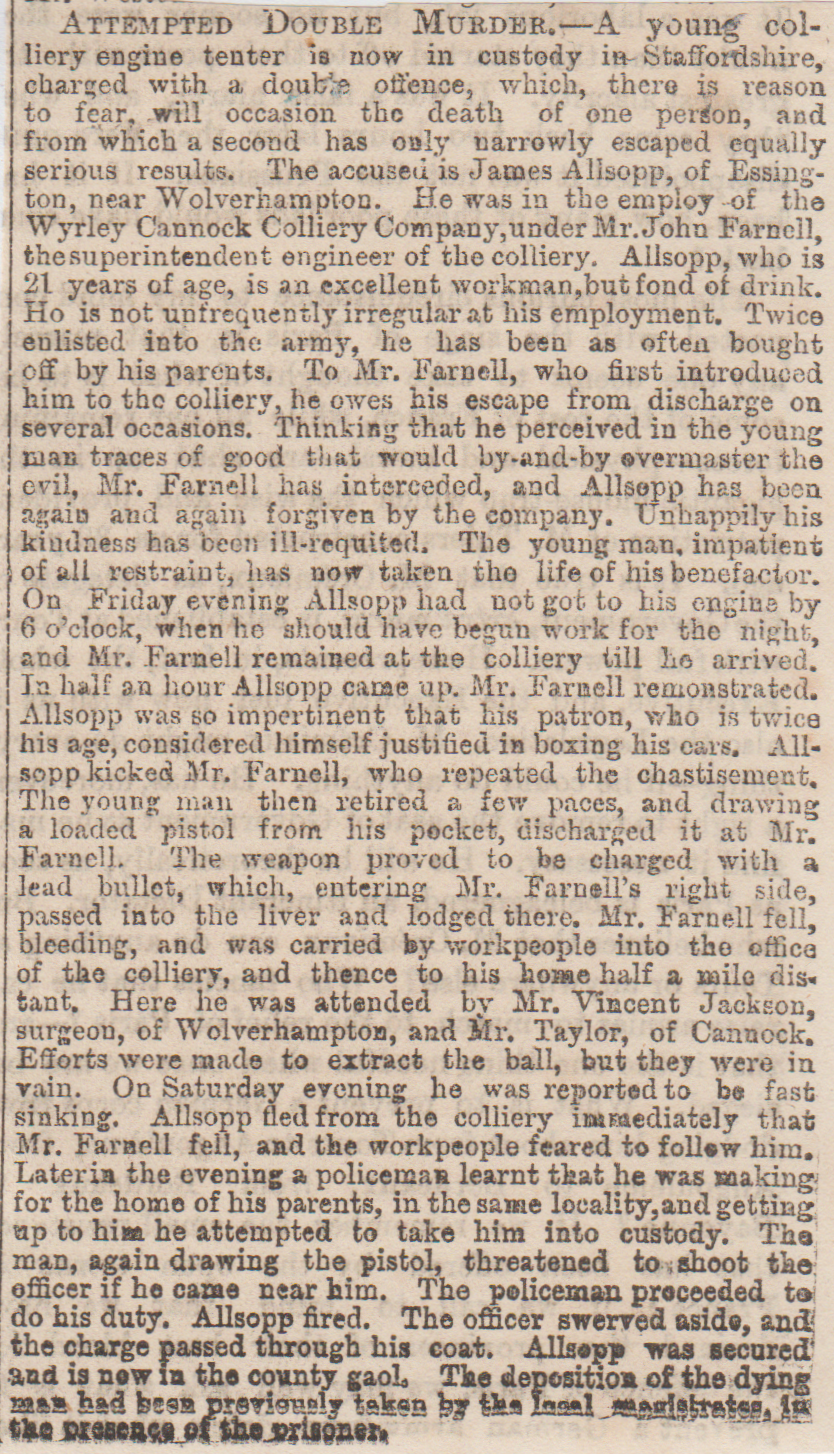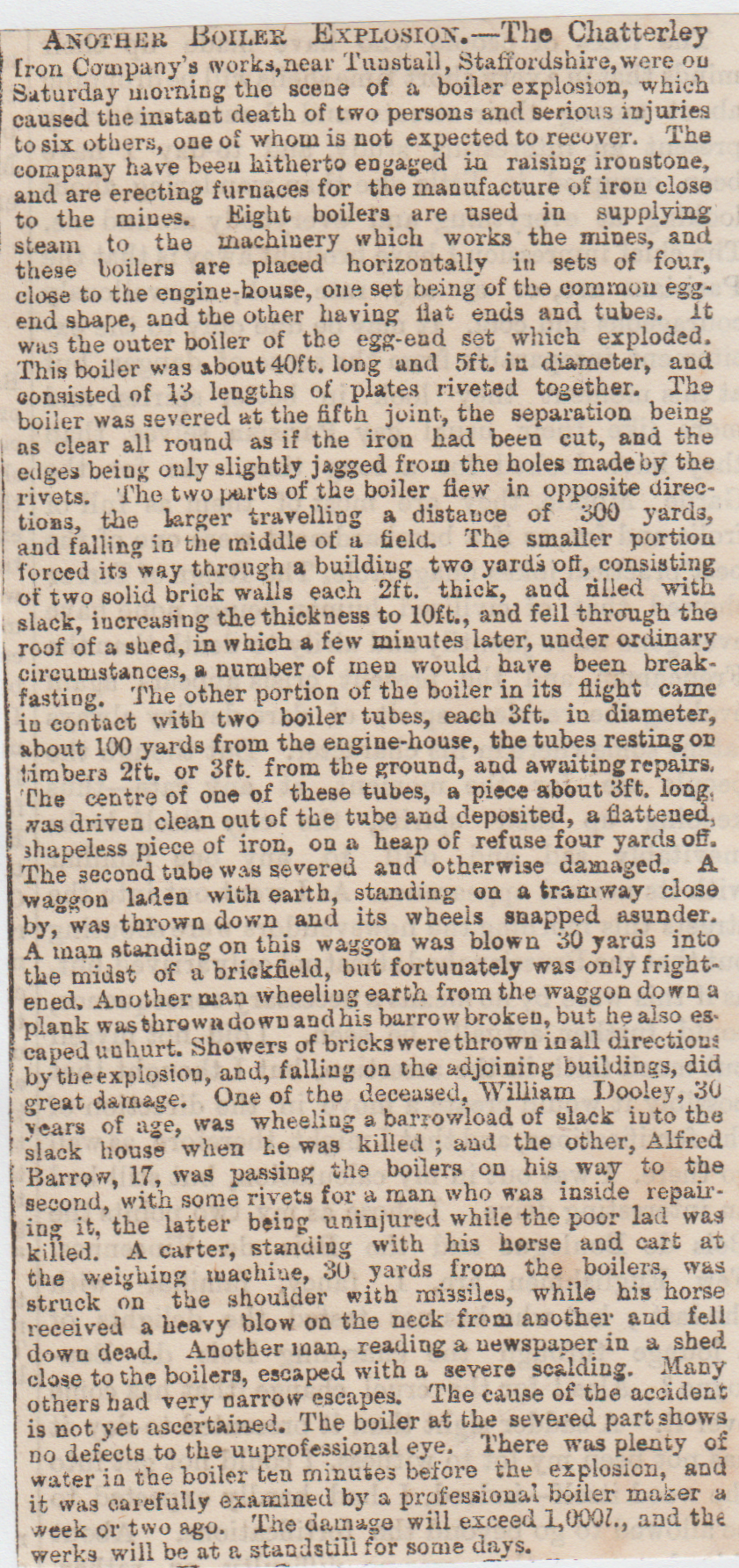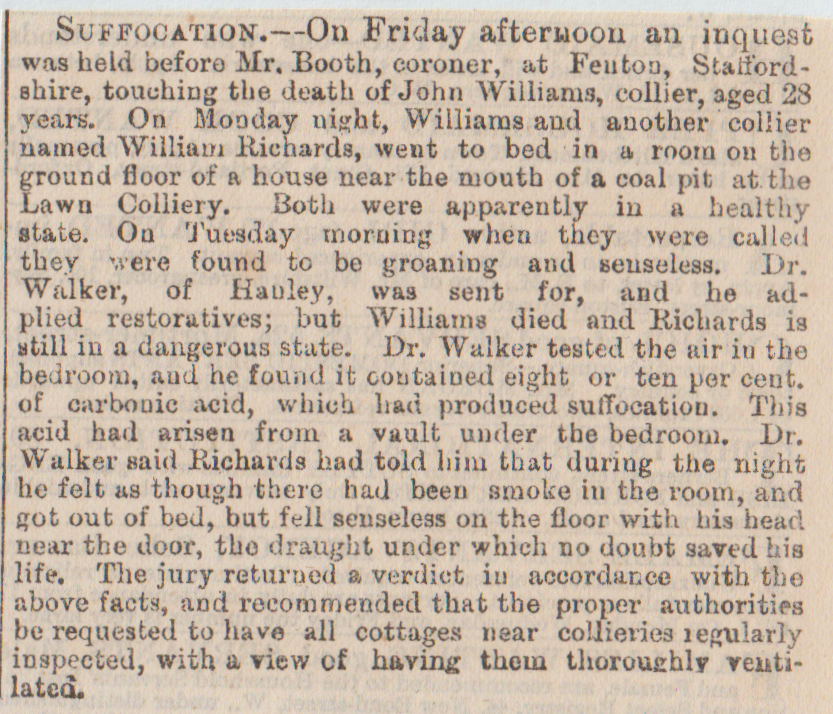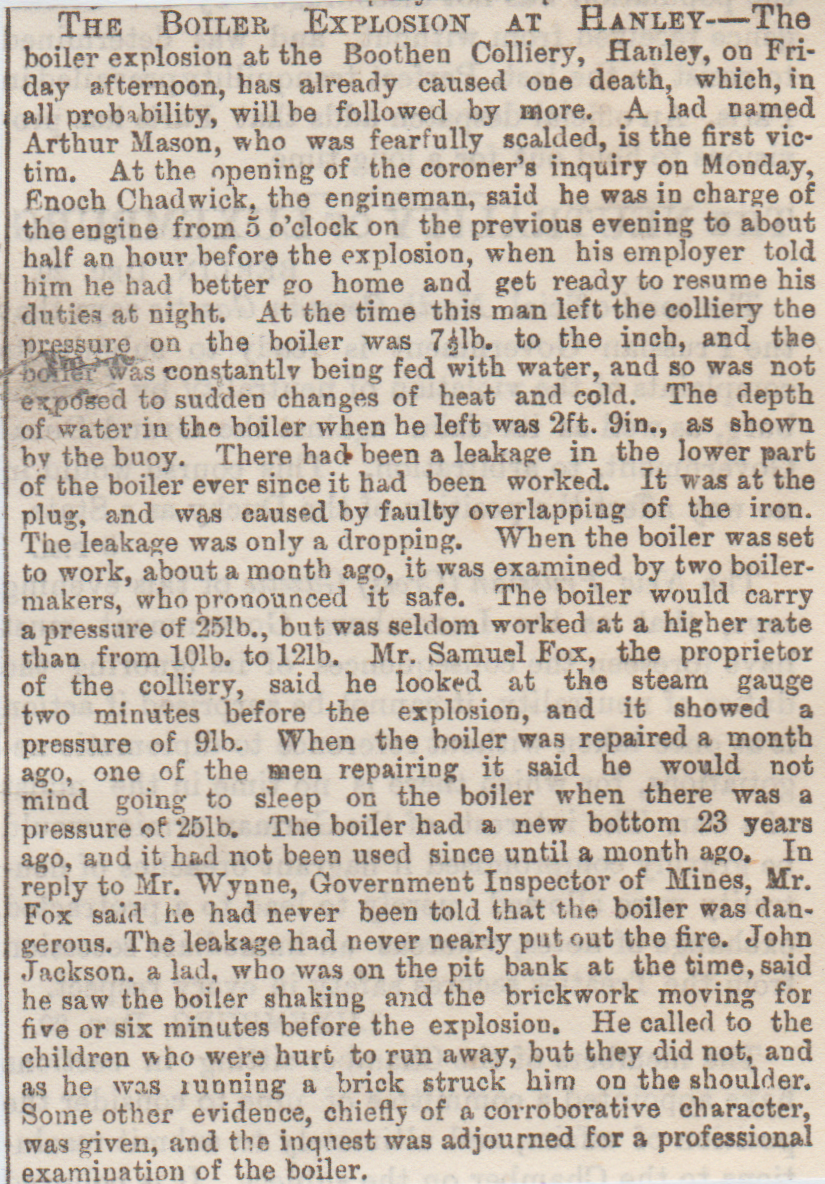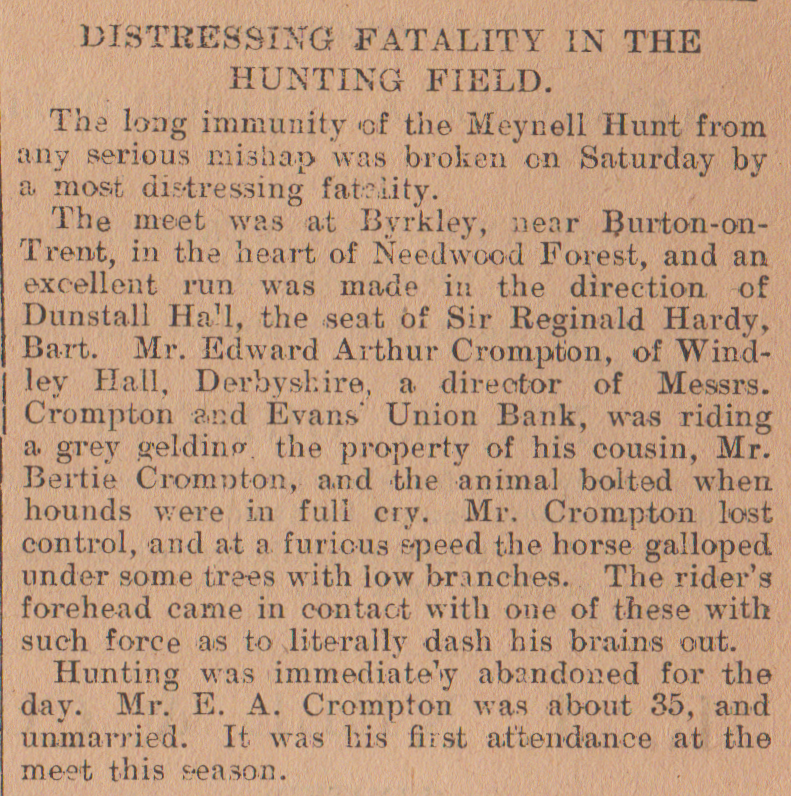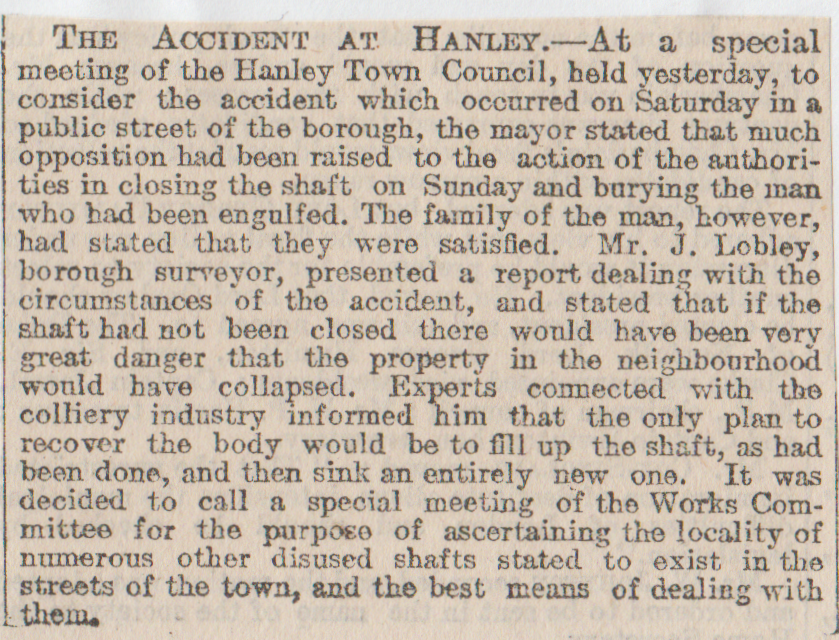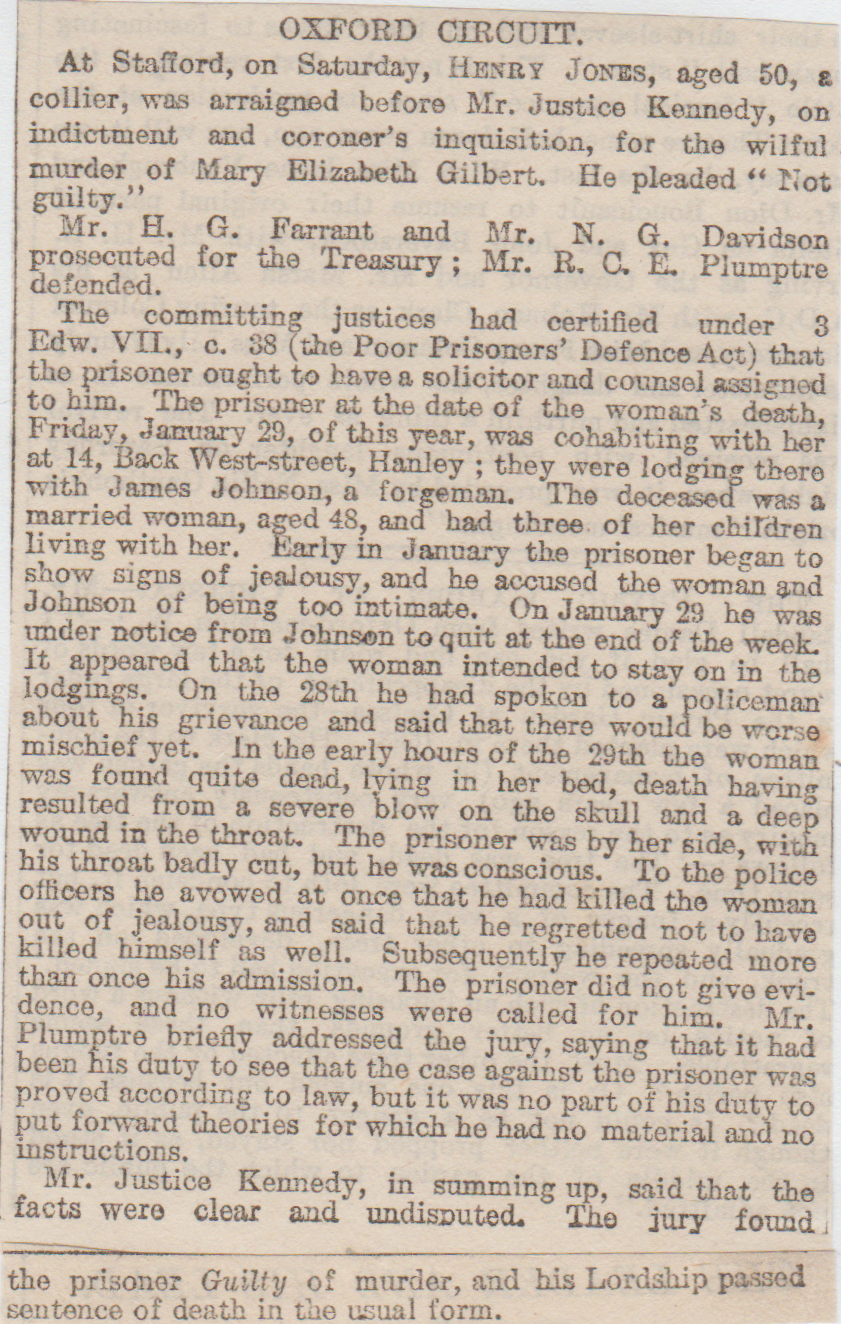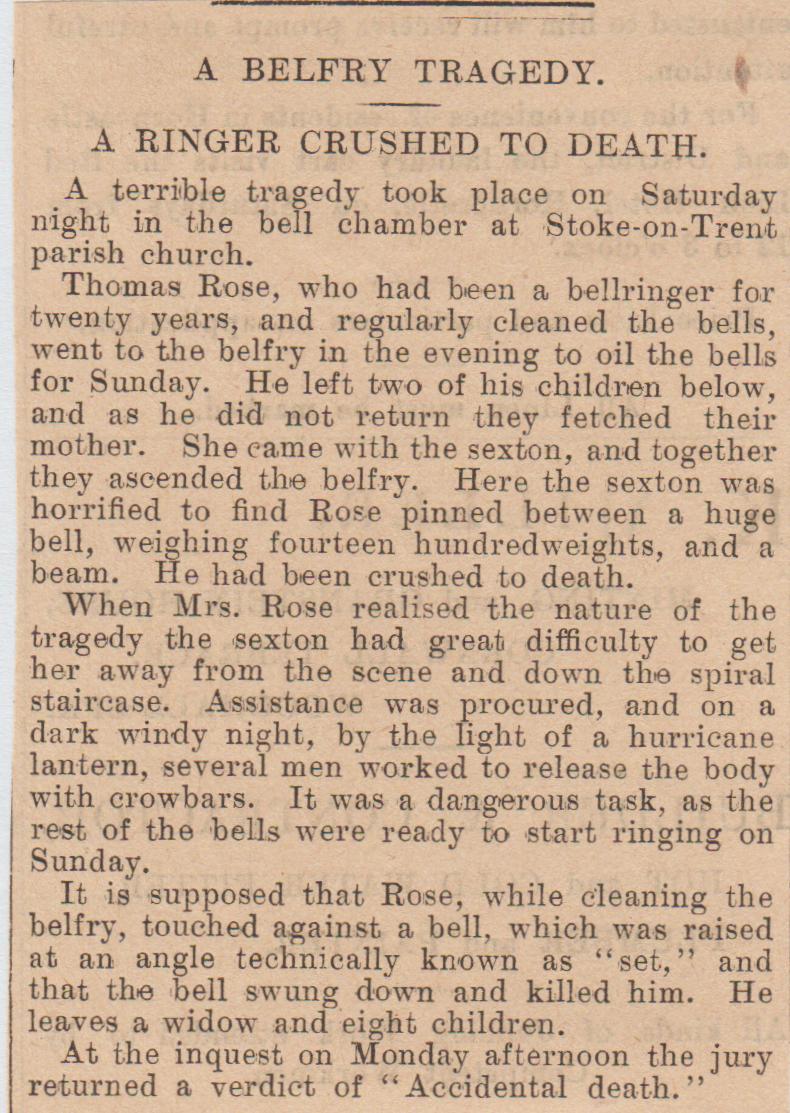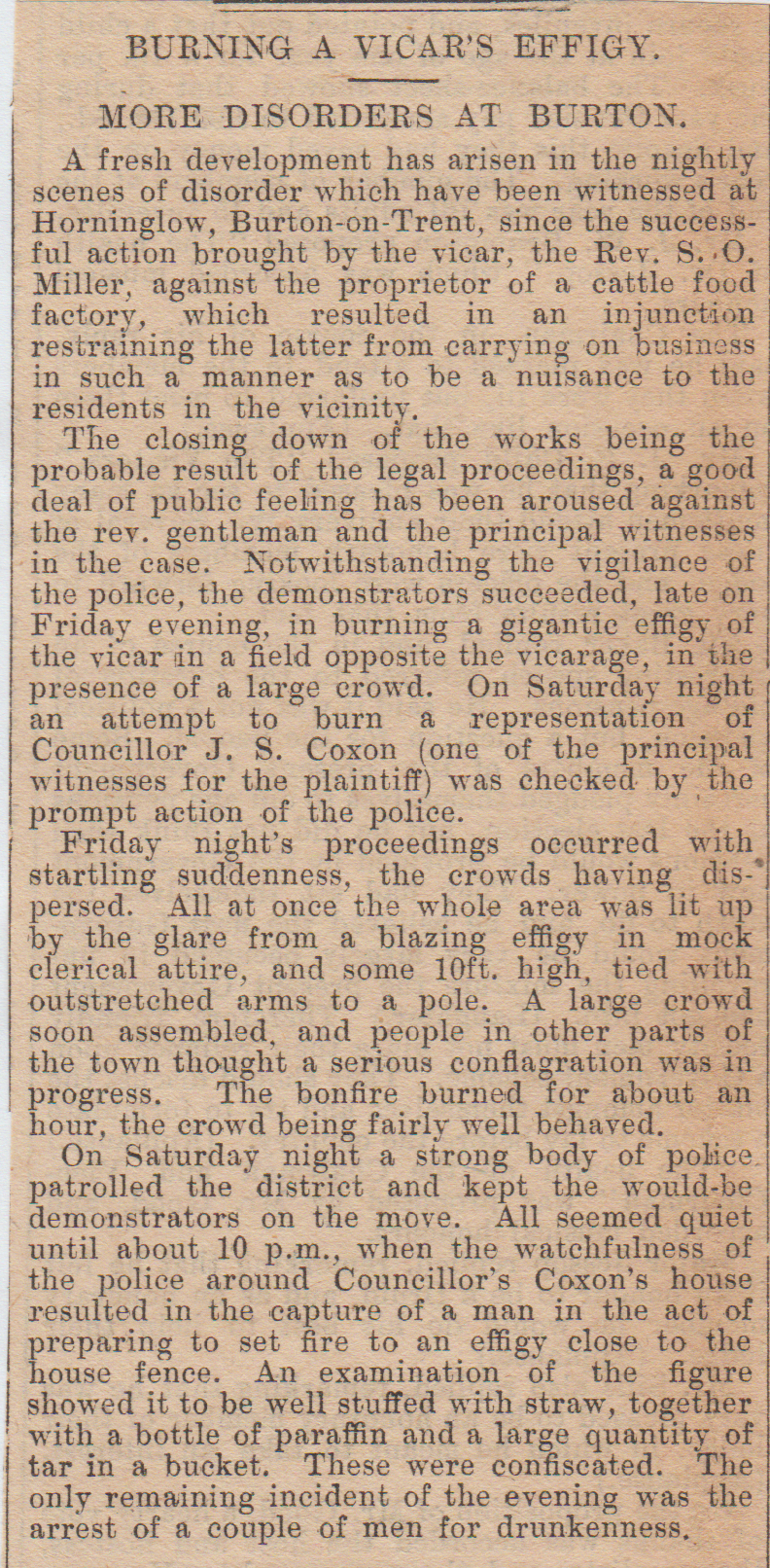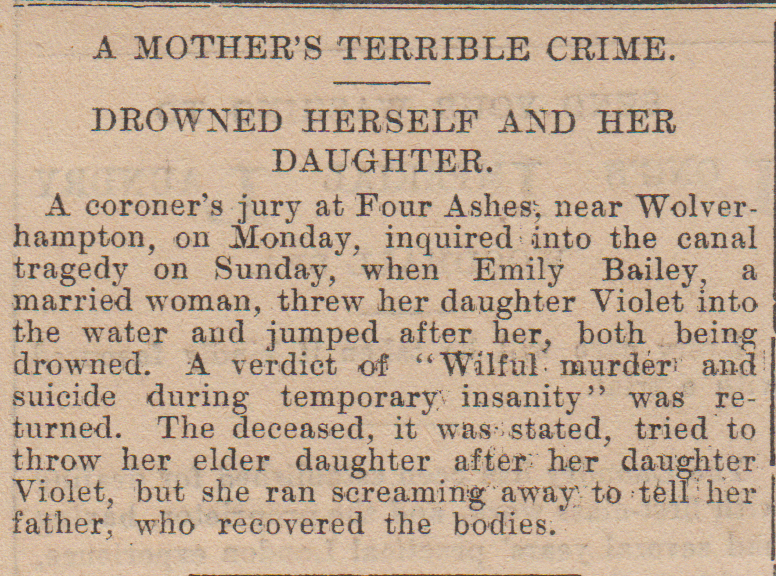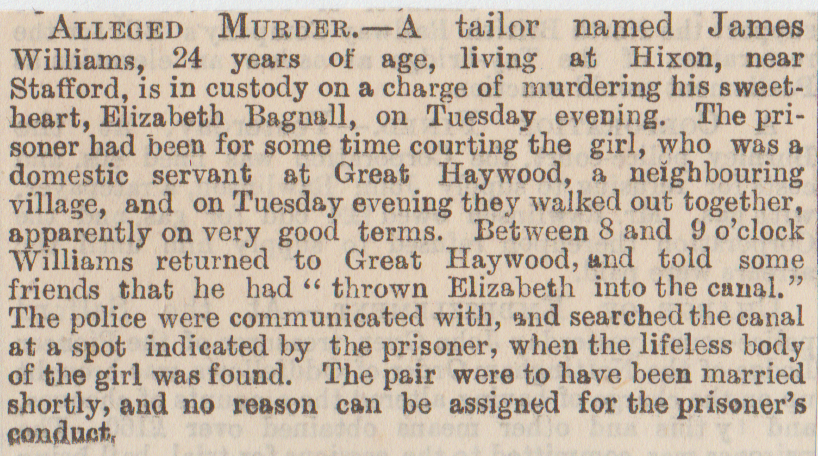1/ Cheadle Murder, (Mysterious Affair) June 1870 (Also see No.51)

2/ Kinver Church, October 1867 (Infants Corpse Found)
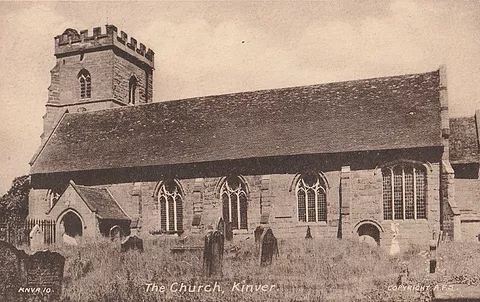
Some charcoal-burners were drawing water from an old pit-shaft when they found a piece of a woman’s sleeve in their pail of water. They sent down another bucket and examined the contents of a guano-bag they brought up, to their horror they found the tiny decayed remains of an infant. The child had on a night-gown and a brick was attached to the bag. The coroner said that the child had been in the water for eighteen months or so and it was so decomposed that cause of death was impossible. He also demanded that the pit was drained. It was and a second child was found, the skeletal remains anyway. This second had been there a lot longer than the first. Further digging around produced a third body, deeper than the other two. The remnants had no flesh and were of a six-year-old boy. The legs had been tied together and there is no doubt he was brutally murdered. (Are they buried in the churchyard? Who were they? Captured murderer?)
3/ Silverdale Poisonings, September 1906
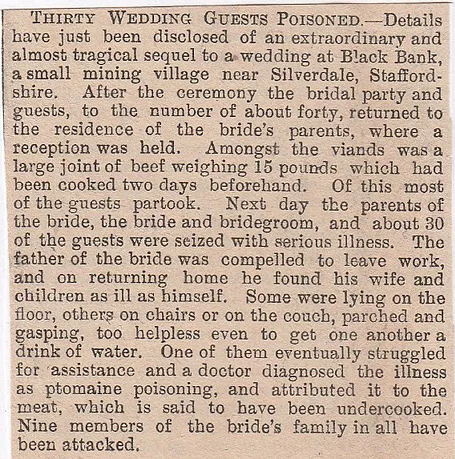
4/ Newcastle-under -Lyne Cemetery Suicide, July 1908
The corpse of a forty-year-old man was discovered in Newcastle (Staffs) Cemetery with a bullet wound in his mouth and a revolver by his side. He was later Identified as a solicitor’s clerk by the name of Herbert.E.Edge. (Buried there?)
5/ Stafford County Asylum, June 1860 (Murder?)
A night-worker at the Stafford County Asylum named Mary Robins heard a scream in a chamber that two inmates were occupying, so she opened the door and saw Anna Hall beating up eighty-year-old Susannah Rhodes and demanding to know why she didn’t give her any brandy. Staff managed to pull her off and lock her in another room. Medical attention was needed for Rhodes, but despite best efforts, she died that night of her injuries. A post-mortem revealed that she had eight cracked ribs and cuts and bruises. Rhodes had been an inmate of the asylum for forty years and had been there since it was built in 1820. Hall had been there four months and was suffering from a mental condition known as “mania after childbirth”-would that be post-natal depression now.
6/ Coton Hill Asylum Suicide, Stafford, August 1863 (See No.17)
John Alcock an inmate of Coton Hill Asylum, Stafford, died the previous evening when he was walking down the stairs with an attendant when he bolted off and headed for the roof via an open window. Another member of staff saw him and tried to catch him before anything untoward happened, but Alcock fell from the building. He lingered a couple of hours but died later on. The jury recommended that the windows have fasteners fitted to them in future.
7/ Stafford County Asylum Suicide, August 1864
An attendant at the Stafford County Lunatic Asylum named Challinor committed suicide by leaping off the roof of one of the buildings. He died instantly and was horribly mangled, falling a distance of seventy feet.
8/ Armitage Train Crash, March 22nd, 1899
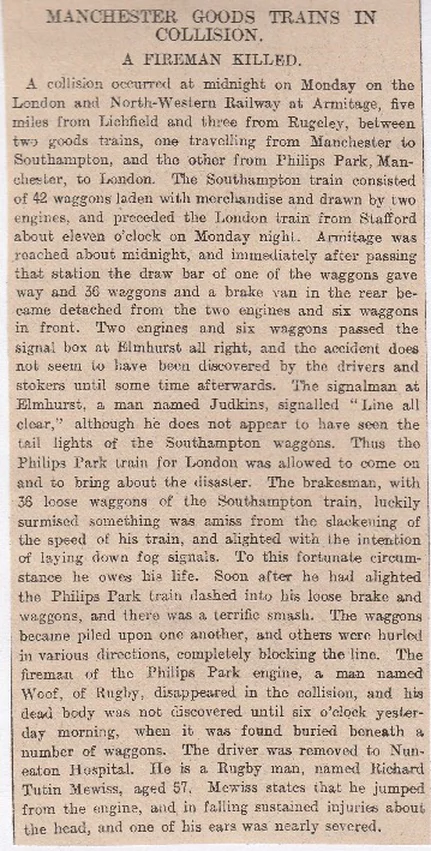
Armitage Train Crash, April 14th, 1899
An inquest was held at Lichfield yesterday on the body of William Wolfe, fireman, who was killed in a collision on the London and North-Western Railway at Armitage near Lichfield. Owing to a flaw a drawbar on a goods train gave way and thirty-five waggons which became detached were dashed into by another goods train, of which Wolfe was the fireman. A verdict of accidental death was returned.
9/ Oldhill Double Suicide, May 1892
Harry Pugh and Ann Gill were lovers and both decide in a suicide pact, by drowning in the Pig Lane Pool at Oldhill. They both entered the water and Ann was drowned, but Pugh survived and got out. He was arrested (You could be tried for murder if a double suicide took place, and one survived it) and admitted to police that they had struggled and that he held her under till she drowned. Her body was recovered the next day.
10/ Wallgrange and Endon, January 1899 (Railway Fatality)
On Monday night, William Bentley of Birches Head, Hanley, was walking along the line between Wallgrange and Endon on the North Staffordshire Railway when he was struck in the back by a goods train and killed. It is supposed that the wind prevented his hearing the train.
11/ Perry Bar Child Murder, March 1899

12/ Burntwood near Lichfield, May 1852 (Vicars Fatal Accident)
An accident occurred at Burntwood which resulted in the death of the Reverend R.Errington. His garden had become overrun with sparrows and he went up a ladder to get some of the nests and destroy them. He climbed one pear tree next to the house (Vicarage?) when a branch snapped and he fell twenty feet to the ground and landed on his head. His wife had just come out to warn him to be careful up there. He was killed outright.
13/ Stone Hunting Fatality, December 1885
The death has been reported as having occurred at Stone in Staffordshire last Saturday, in consequence of an accident in the hunting field of Captain Richard Tylden, Royal Artillery, who for nearly two years had been attached as adjutant to the Shropshire and Staffordshire Artillery Volunteers. Captain Tylden was in his twenty-eighth year.
14/ Longton Station Fatal Accident, September 1885
A fatal accident occurred near Longton Station on Tuesday night. William Lockett aged seventeen years was crossing the line about eight o’clock when a passenger train from Derby to Stoke came up at full speed and ran over him, killing him on the spot.
15/ Woodhouse Wife Murder, near Lichfield, March 1st, 1899

16/ Woodhouse Wife Murder, near Lichfield, March 2nd, 1899
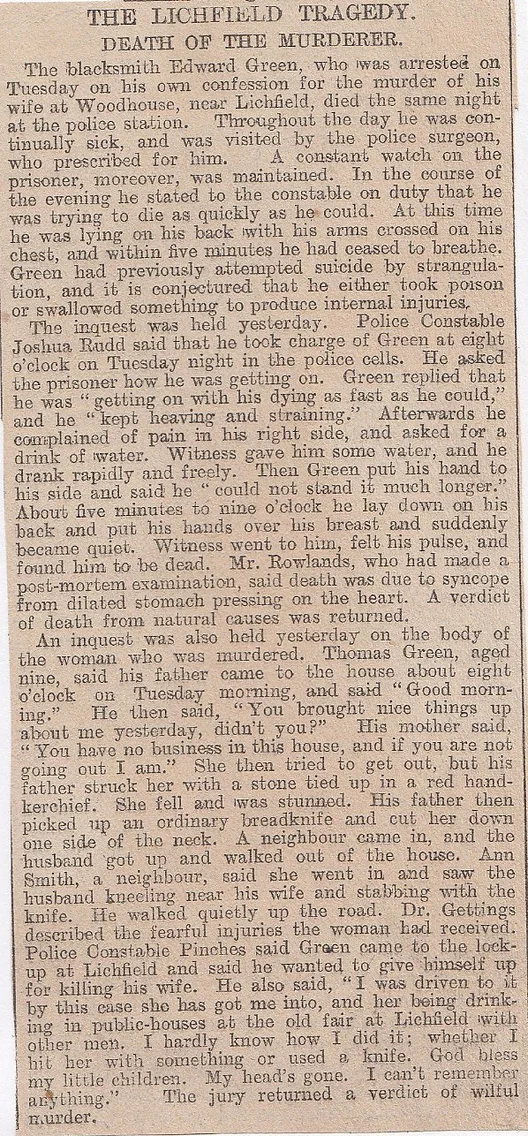
17/ Coton Hill Asylum Suicide, February 1878 (See No.6)
An inquest was held on the death of a patient of the Coton Hill Private Asylum, Staffordshire. Mr Fielding Nevins, a gentleman from Shrewsbury, was suffering from religious mania and he was left unattended for a few minutes one day when he jumped through a window and fell thirty feet. He then got up, got a shard of glass and slit his throat from ear to ear. He died as a result of the separation of the jugular vein.
18/ Burton-on-Trent Suicide, May 1861
A man committed suicide in a strange way near Burton-on-Trent. He was involved as a complainant in a police case and he was found dead in a ditch with a pen-holder jammed into his throat. A pair of glasses were held in his hand and his chest was badly bruised. Police discovered a letter addressed to his wife and brother saying that because of some unpleasantness at work, he decided to end it all and could they pray for him and forgive him.
19/ Stafford Gaol Execution, August 1885
Thomas Boulton was executed in Stafford Gaol yesterday morning for the murder of Elizabeth Bunting, his niece who was fifteen years of age at Handsworth near Birmingham, in April last. The condemned man walked firmly to the scaffold and appeared to die almost immediately. Berry was the executioner.
20/ Burton-on-Trent Boating Death, July 1889

21/ Cobridge near Hanley, March 1885
On Saturday evening a child two years of age, son of a potter named Smith, was playing in the road at Cobridge near Hanley when it ran in front of a tram engine, which passed over it causing injuries of such a shocking character that the child died almost immediately afterwards.
22/ Sandford Hill Child Murder, near Longford, January 1900
A dreadful case of a mother murdering her child occurred at Sandford Hill near Longford. Lydia Bates, a colliers wife, had been put in an asylum on several occasions and had been behaving strangely recently. She hit her eight-year-old son on the head, killing him, then washed the body ready for his burial. When arrested, she told police she was going to kill her two daughter’s as well and then commit suicide as the Lord himself had told her to it.
23/ Potteries Suicides, April 1899

24/ Bradley Factory Deaths, June 1899 (Twenty Tons of Metal on Three Men)
Yesterday afternoon a shocking accident occurred at a galvanizing works at Bradley, Staffordshire. By some unaccountable means, about twenty tons of galvanized sheets fell on three men, killing one immediately and maiming the other two for life. The man killed was Arthur Horton aged twenty-two, a galvanized sheet inspector.
25/ Etruria Station Suicide, June 1899
Last evening as the 5-30 express from Stoke-on-Trent to Manchester was passing through Etruria Station, a man of middle age, who had been standing on the platform, threw himself in front of the approaching engine. When the train had passed he was found to be fearfully mangled, death having been instantaneous. The man who was fairly well dressed was last night still unidentified.(Who was he?)
26/ Cavendish Bridge Brewery Fatality, near Burton-on-Trent, April 1851
A fatal accident occurred at the Cavendish Bridge Brewery, when John Sheffield an employee at the brewery, fell into a vat filled with port. He was quickly dragged out, but the sixty-year-old was dead. The owner of the brewery emptied the contents of the vat into the Trent and was about 2880 gallons, worth about £200. (What a way to go though!)
27/ Chell Colliery Explosion, Hanley, August 1889

28/ Rowley Hall Colliery Fatality, May 1899
An inquest was held concerning the death of William Ashman, who lost his life at Rowley Hall Colliery and it was also shown that four miners showed incredible heroism. Ashman had been knocked down by a fall from the roof. For three hours the miners, amidst the repeated showers of slack, attempted to rescue the poor fellow and four times they got him to the surface alive but were knocked down. The miners were commended for their gallantry. The verdict was “Accidentally Suffocated”.
29/ Hanley, August 1905 (Suicide Note)
The search for Annie Tunnicliffe of Hanley, who vanished on Monday, when she was meant to have been wed, has resulted in a strange letter being found in Annie’s bedroom.
“Goodbye to all. I am better off the earth than I am on it. Mother and Father, don’t worry after me. You will know the ending of me. There is none of my sister’s that give me a good name, but hoping that they will all follow me to the cemetery. Don’t worry after me. Give my best love to Sam (her lover), and especially tell him “Not married on earth, but married in Heaven”.
Police have searched the area and dragged the canals, but to no avail. (Was she ever found?)
30/ Burslem, (Eccentric Woman) May 1899
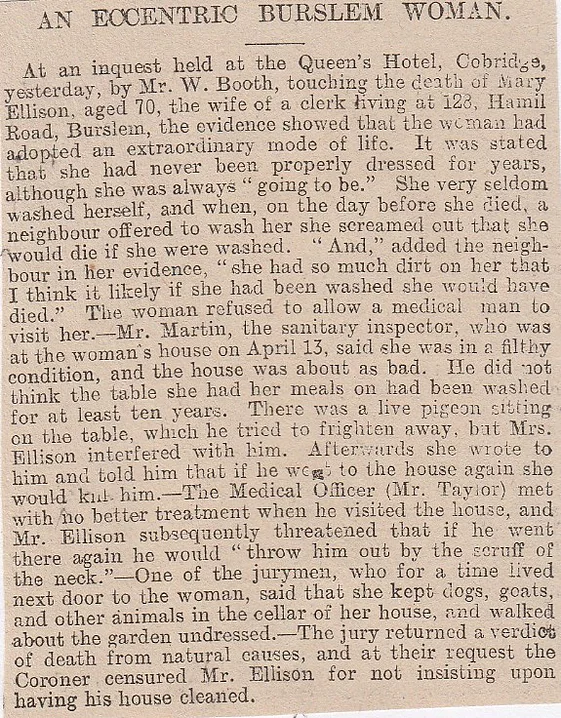
31/ Burslem Murder, April 21st, 1885
At Burslem on Sunday, the dead body of a young woman named Clara Jessie Vernon aged eighteen of Stanley Street, Burslem, was found lying in a ditch close to the canal at Middleport. She was seen on Saturday night with a potter name Henry Ford with whom she had been keeping company and who is now in custody, on suspicion of causing her death. The deceased, it is said, was intoxicated when last seen on Saturday night.
32/ Burslem Murder, April 23rd, 1885 (Inquests Verdict)
At the inquest held yesterday on the body of the young woman Vernon, who was found dead in a ditch near Burslem on Sunday morning and whose sweetheart, a young man named Ford was arrested on suspicion of causing her death. The medical evidence pointed to death having been caused by suffocation, brought on by an epileptic fit, which might have resulted from excessive drinking. A verdict was given accordingly and Ford as released.
33/ Stoke-on-Trent Railway Collision, January 1885
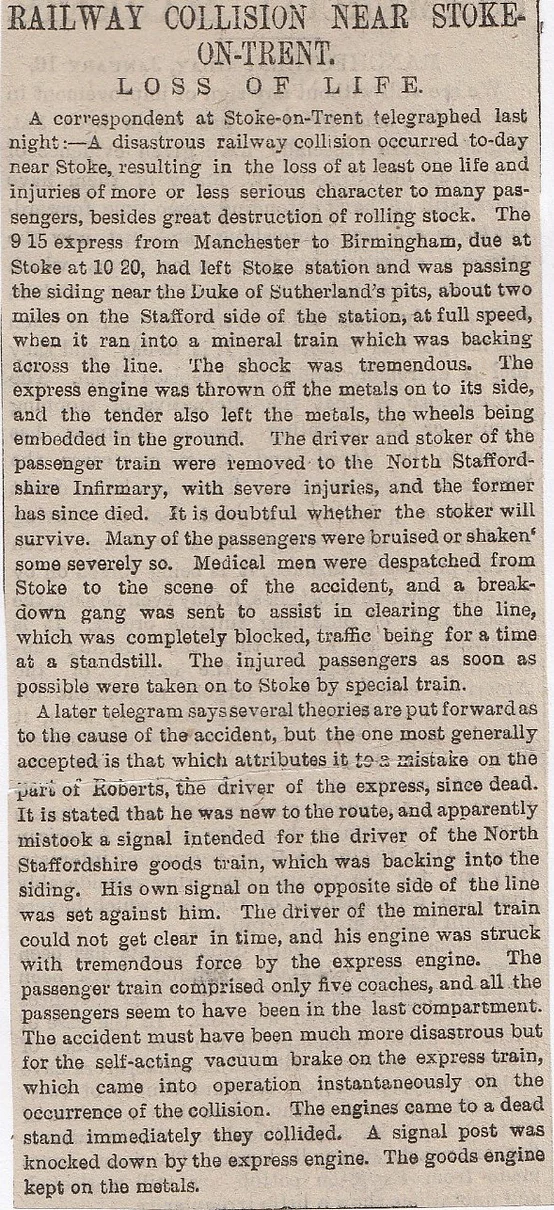
34/ Stoke-on-Trent Railway Collision, February 1885
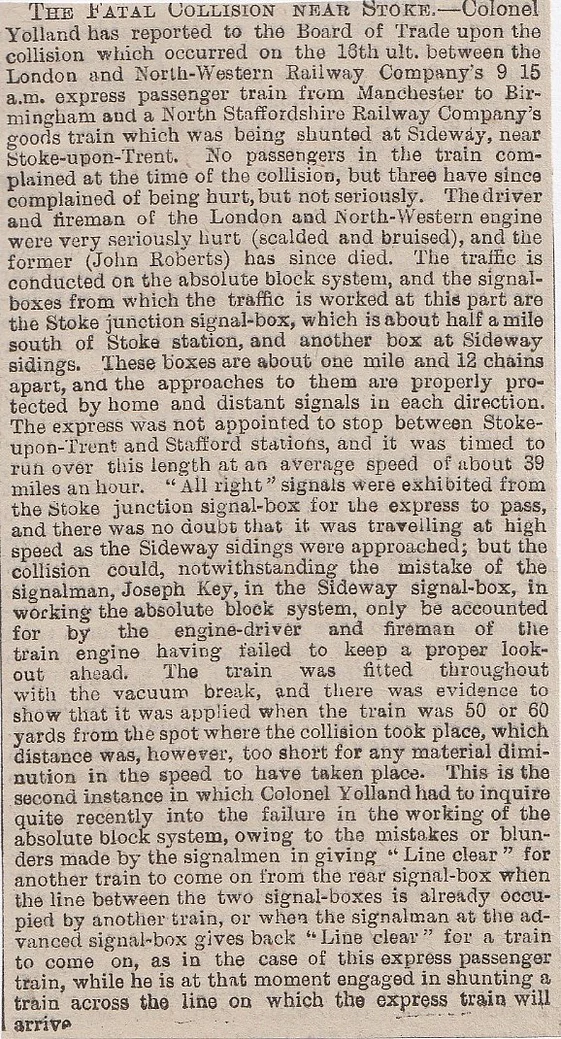
35/ Stoke-on-Trent Inquest, April 16th, 1885
The adjourned inquest on the body of John Roberts of Manchester, driver of the express which came into collision at Sideway siding near Stoke-on-Trent in January last, was held at Stoke yesterday. The jury, in returning a verdict of accidental death also found the blame attached to the signalman, Key, for signalling the line clear, when the goods train was upon it and that deceased contributed to his death by passing the danger signals.
36/ Weston-on-Trent near Stafford, July 1910 (Suicides Hallucinations)
An unknown man thought to be from Manchester and whose body was pulled from the canal at Weston-on-Trent near Stafford, left the following letter in his pocket. It read :
My Dear Marjory- I think I have been mad since I left Manchester in the way I did. Why I did so I cannot say to this day. I should have faced the music, but I was always a moral coward, and even now I am the greatest coward of all. But I cannot do else, as I am reduced to my last farthing, and last night I slept out in the fields. On Saturday night, about 11 o’clock, I am certain I was mad, because as I walked along all the hedges seemed to become ghosts of people gone before,who seemed to be trying to pull me down to them, and early this morning as I walked along the high road, ghosts of people would appear and in some cases were so vivid that I said “Good morning”. They dissolved into space, and my blood ran cold. What have I been, whoever I have been, God knows I have suffered this last week; in fact, I have lived a little hell.
Dear Marjory, Try to forgive, because, how I have behaved, I have always loved you dearly, and now God bless you, my dear sister, and may He pour down upon you the sweetness of His blessing. Goodbye dearest, forgive all this trouble I have brought upon you-Your loving brother, Horace.”
The inquest evidence said that he put bricks and rubble in his pockets to weigh him down and when found, it had been in the water about five or six days and the body was standing up in the canal.
37/ Malkin Tile Co., Longton, June 1899 (Lead Poisoning. See No.46)
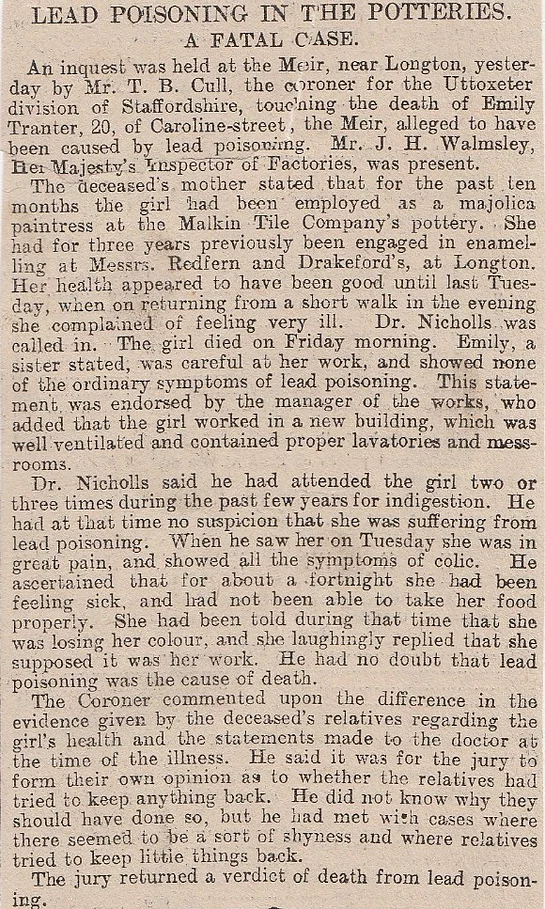
38/ Stoke Racecourse Fatal Tragedy, August 1854
At the races at Stoke in Staffordshire, just as it was about to begin a crowd of people rushed toward the booths and stands and then it collapsed with a frightful crash. A stand fell upon the crowd below and a great panic started, with folks desperately trying to get out from under the debris. Thomas Windsor was dragged out, but sadly he was already dead. Then out came Mary Ann Fannerly, a married woman who was separated from her husband. Her chest cavity was caved in and brain protruded from her nostrils. Nearby was her paramour, Thomas Burns, who died later from severe injuries. The chap, Windsor, left behind a wife and five kids and the other two also left children.
39/ Longton Fatal Fight, February 1892

40/ Stoke-on-Trent Bridge Suicide, May 1885
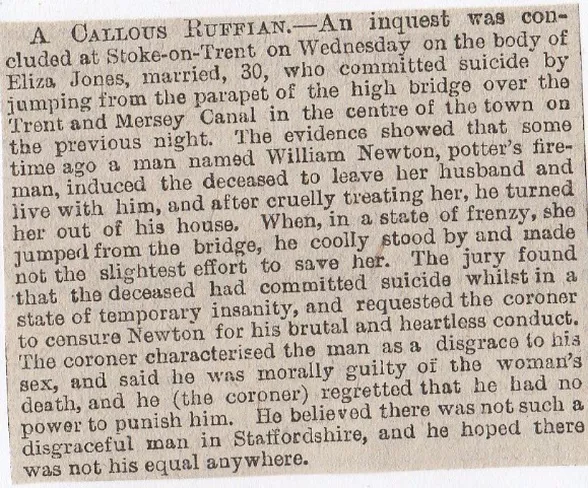
41/ Burslem, May 1882 (St Paul’s Churchyard Suicide)
An amazing ceremony took place at Burslem, performed by the Bishop of Lichfield. A couple of months ago a young man named Blaze, killed himself by hanging over his wife’s grave. The burial ground was then deemed to have been polluted and the ground had to be reconsecrated. The Bishop said of the suicide- “We may well believe that such an act could not be done except under the influence of a disordered train (of thought), but we must always remember that in too many instances, it is the conduct in former years that produces disorder. Apart from all other evils and from the many which may bring about such a state of things, there is one above all others, which I am sure must suggest itself, because we see so continually its evil effects- I mean that awful habit of intemperance which is ruining the bodies and soul of thousands around us.”
42/ Hanley Manslaughter, February 1899 (Sorry about the corner, the paper was weak and collapsed!)
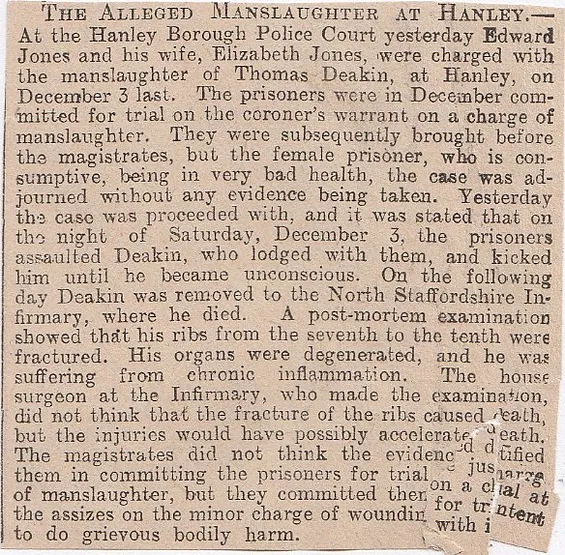
43/ Whittington Barracks Suicide, Lichfield, July 1904
No 1400 Sergeant Frank Charles of the 4th South Staffs Militia, went to the Sergeants mess of the 1st North Staffs Regiment at eight a.m. It just outside the barracks and going through the kitchen he saw a rifle and turned back to examine it. Then a gunshot was heard and a man found him with terrible facial wounds. Charles had put the gun under his chin, then pulled the trigger. He was taken to the hospital and he lived on for a couple of hours, then passed away. Deceased was married and when they informed his wife of what had happened, then a distressing scene followed. Since returning from South Africa, Sergeant Charles had been an orderly room clerk, then was returned to regimental duty and the duties of the orderly room went to another non-commissioned officer. This annoyed him, to say the least, he thought suicide was the best answer, rather than return to regimental duty.
44/ Winshill Murder near Burton-on-Trent, June 1879
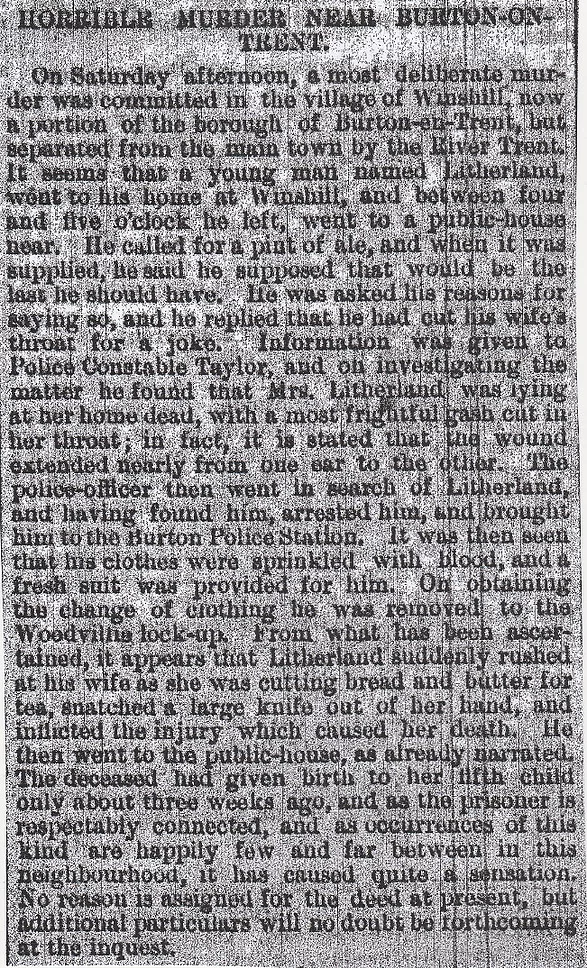
45/ County Prison Warder Suicide, Stafford, December 1866
One of the warders, called turnkeys in those days, by the name of Thomas Parker, killed himself while at the prison by hanging himself from the ceiling of the store-room. He had worked at the prison for twenty years and had accrued some property and managed to save a few quid as well, but for quite a while he had been suffering from depression. A letter that was written before his death mentions the fellow turnkey who had been put inside for two months for supplying tobacco to the prisoners. The general consensus was that he was somehow involved as well and although he wasn’t, this weighed heavily on his mind. A verdict of “Temporary Insanity.”
46/ Longton, January 1899 (Lead Poisoning & Starvation, See No.37)

47/ Apedale Colliery near Newcastle-under-Lyme, June 1885 (Nine Deaths)

48/ Tutbury, November 1899 (Eaten by Pet Mice)
Seventy-one-year-old Palmea Porter lived alone in Tutbury and was in receipt of parish relief. The one thing that kept her going was her pet mice, but this would come back to haunt the woman. A neighbour of Palmea’s hadn’t seen her for a while and was concerned, so he asked the police to intervene and enter her property. Sergeant Walker got into the house and saw her in an armchair, with portions of her face and head eaten away by her beloved rodents and the body was badly decomposed. The mice had made nests in the furniture, while poor Palmea lay there, dead. She died of natural causes though.
49/ Great Fenton Colliery Explosion, April 9th, 1885


Great Fenton Colliery, April 18th, 1885
John Bithell of Hanford, the fireman who was injured by the explosion at the Great Fenton Colliery on the 8th inst. and had since been lying at the North Staffordshire Infirmary, has succumbed to his injuries. This makes the seventh death in connection with the explosion.
50/ Hednesford, (Lion-Tamer Killed), March 1892
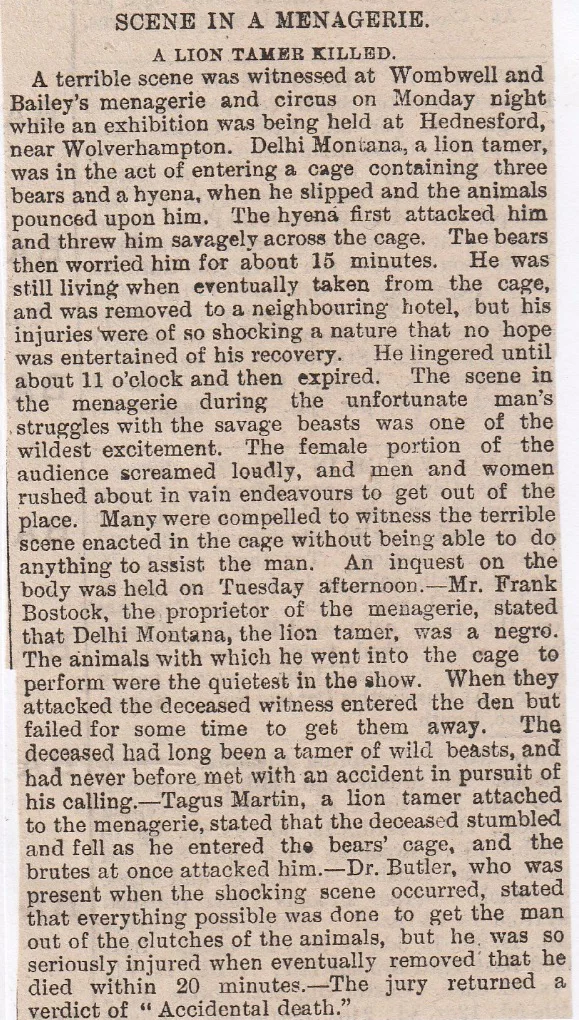
51/ Dilhorne Murder Confession, July 1870 (See also No.1)
52/ North Staffs Coal & Iron Company, Talke, (Four Men Suffocate to Death) July 1870
53/ Wyrley Cannock Colliery Murder, September 19th 1870
September 20th,1870.
After the despatch of our parcel on Saturday evening, Mr John Farnall, superintendent engineer of the Wyrley Cannock Collieries Company, succumbed to the injuries inflicted with a pistol by James Allsopp, a young engine-tenter under him. The deputy coroner for South Staffordshire, Mr W.H.Phillips, opened the inquest last night. The prisoner Allsopp will be taken before the magistrates today, at Penkridge, near to Wolverhampton.
54/ Chatterley Iron Co., near Tunstall (Fatal Boiler Explosion) September 1870
55/ Silverdale Colliery Explosion, July 9th 1870
July 15th 1870 Coroner’s Inquiry.
The coroner’s inquiry as to the death of the nineteen men who were killed by the explosion of gas in Messrs.Stamer and Co’s. colliery, Silverdale, on the 7th of July, was resumed yesterday. At the close of the evidence, the Coroner summed up, and the jury, after consulting for half an hour, found that the deceased were killed by an explosion of gas, but how that occurred there was no evidence to show. They considered, however, the return air-way was too small for the extent of the workings and recommended that it should be enlarged.
56/ Lawn Colliery Fatality (Death by Suffocation) December 1870
57/ Fatal Explosion at Hanley (Boothen Colliery) December 1870
58/ Cannock Colliery Manslaughter, December 1870
59/ Hunting Fatality near Burton-on-Trent. December 1902
60/ Man Falls into Hanley Sinkhole, Stoke-on-Trent. December 14th,1903
December 15th, 1903. Hanley Pit-Shaft Tragedy
61/ Murder in Hanley, Stoke-on-Trent. March 14th, 1904
Wednesday, March 30th, 1904. (Execution of Henry Jones)
Henry Jones, aged fifty, and a collier, was hanged at Stafford yesterday morning for the murder of Mary Elizabeth Gilbert, at Hanley, on January 29th. Jones made no attempt to deny his guilt. Being a Methodist, he was offered the services of a Nonconformist minister, but he expressed himself satisfied with the ministrations of the prison chaplain. It is understood that Jones unsuccessfully appealed to the Home Secretary for a reprieve.

